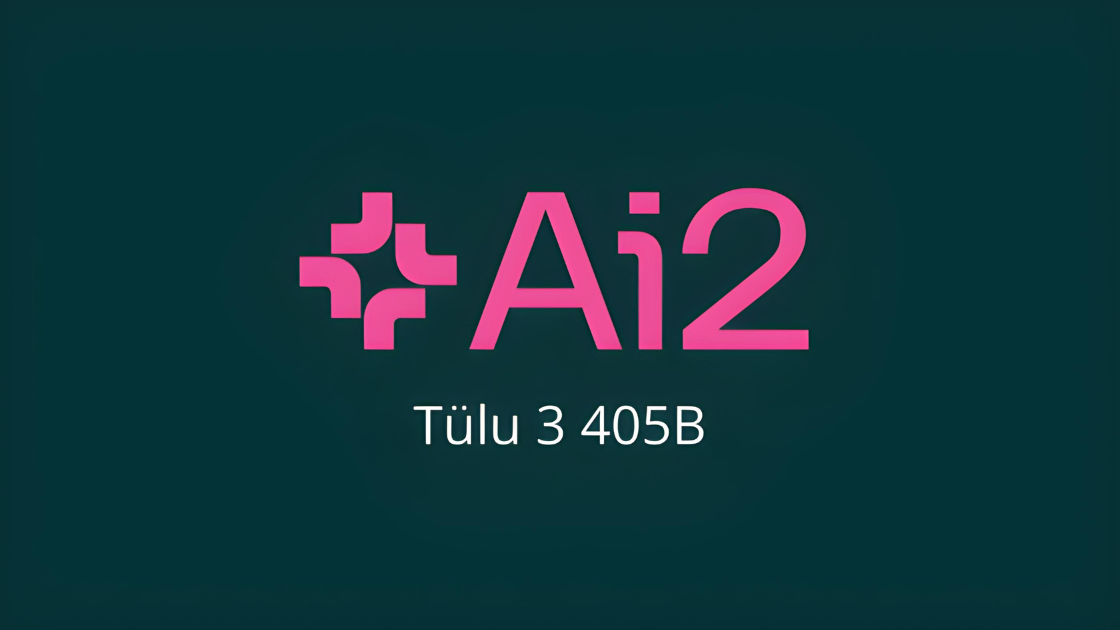Artificial intelligence is changing fast, and now there’s a new player on the field that is turning heads everywhere. Meet Tulu 3 405B, a huge open-source AI model released by AI2, also known as the Allen Institute for AI.
With 405 billion parameters, this model is one of the largest and most powerful open-source AI systems out there. And the best part? It is completely open-source, which means anyone can download, use, and learn from it.
In this article, we’ll break down what makes Tulu 3 405B so special, explain its key features, and even walk you through a simple tutorial on how to use it in a friendly playground environment. Don’t worry—everything is explained in simple and easy-to-understand language. Let’s dive in!
What is Tulu 3 405B?
Tulu 3 405B is a cutting-edge AI model created by AI2. It is called “405B” because it has 405 billion parameters.
Parameters are like tiny switches inside an AI model that help it learn patterns and make predictions. The more parameters a model has, the more information it can process and the more complex tasks it can handle.
Why is it Important?
- Huge Size: With 405 billion parameters, Tulu 3 is much larger than many other open-source models. For example, some models only have up to 72 billion parameters. This huge size means that Tulu 3 can understand and generate text in a way that is very similar to how humans write.
- Open Source: Unlike many models that are kept secret or require expensive licenses, Tulu 3 405B is open for everyone. All of its code, data, and training recipes are freely available. This makes it a great resource for students, researchers, and anyone curious about AI.
- Practical Impact: Because it is so large and powerful, Tulu 3 405B can be used in many fields like healthcare, education, and content creation. Its ability to process complex data makes it a valuable tool for solving real-world problems.
Exploring the Open Source Features
One of the most exciting parts of Tulu 3 405B is its openness. When a model is open source, it means that its inner workings are shared with the world. Here’s what you get with Tulu 3 405B:
- Access to the Code and Data: You can see how the model was built. The training code, the datasets used, and even the evaluation results are all available online.
- Post-Training Recipes: The developers have shared a collection of recipes that show how they improved the model after its initial training. This includes tips on fine-tuning and using reinforcement learning.
- Technical Paper and Benchmarks: If you’re interested in the nitty-gritty details, there’s a technical paper that explains the model’s architecture and performance. You can also see benchmarks that compare Tulu 3 405B to other models.
- User-Friendly Model Page: The model’s page on the website provides a clear overview, a process map that shows how it was built, and links to download everything you need.
This level of transparency is a big win for the AI community. It means that anyone can study the model, learn from it, and even improve on it. It is a practical demonstration that open-source AI can compete with proprietary systems.
Navigating the Tulu 3 405B Model Page
Let’s talk about how you can explore the Tulu 3 405B model online. The model page is your main hub for all things related to Tulu 3. Here’s what you can expect when you visit:
- Overview and Introduction: The page starts with a simple explanation of what Tulu 3 is and why it is important. It gives you a brief history of its development by AI2.
- Benchmarks and Comparisons: You will find performance results that show how Tulu 3 compares to other models, like those from Deep or other AI giants. This helps you understand its strengths and areas where it shines.
- Reinforcement Learning Details: There’s an easy-to-follow explanation of the reinforcement learning framework used in Tulu 3. This method helps the model learn better by rewarding correct answers, especially in tasks like math or logic.
- Links and Downloads: All the code, data, and training recipes are linked here. You can download the model, read the technical paper, and see sample outputs.
- Interactive Demonstration: Often, the model page includes a demo where you can try out the AI directly from your web browser.
Navigating this page is simple, and it’s designed to be friendly to both technical users and newcomers. It gives you all the information you need without overwhelming you with technical jargon.
Getting Started on Hugging Face
Hugging Face is a popular platform for hosting AI models. Tulu 3 405B is available there for anyone to use. On the Hugging Face page, you can:
- Browse Different Models: Although Tulu 3 405B is the star of the show, you can also explore other models and datasets available on Hugging Face.
- Download and Test: You can download Tulu 3 405B and even run it in your own environment if you have the resources.
- User-Friendly Interface: The platform is designed so that both technical and non-technical users can explore and experiment with the model.
Using Hugging Face makes it easy to get hands-on experience with Tulu 3 405B. You can start testing different prompts and see how the model responds right in your browser.
Understanding the Playground
One of the best ways to interact with Tulu 3 405B is through the playground. This is an online tool that lets you experiment with the model without needing to download anything complicated. Here’s how it works:
- Simple Interface: The playground has sliders for settings like temperature and top P. These control how the model generates its text.
- Temperature: This setting controls how random the output is. Lower temperatures make the responses more focused and predictable, while higher temperatures can produce more creative and varied responses.
- Top P: This setting influences how many word options the model considers when predicting the next word. Adjusting this can change the quality of the output.
- Experimenting with Prompts: You can type in a prompt, hit a button, and see how the model responds. It’s a fun way to see the power of a 405 billion parameter model in action.
- No Login Required: You can try the playground without even logging in, although signing in lets you save your chats and come back to them later.
- Learning Through Play: The playground is a great way to learn how large language models work. By adjusting the sliders and testing different prompts, you get a feel for how the model generates text.
This hands-on approach is perfect for anyone who wants to understand AI without getting bogged down in technical details.
Testing the Model with Simple Prompts
When you’re using Tulu 3 405B, you might want to try out a few different prompts to see what it can do. Here are some ideas:
- Creative Writing: Ask the model to write a short story or a poem. Try changing the temperature settings to see how the style shifts from very creative to more formal and precise.
- Summaries: Provide a long paragraph of text and ask for a summary. Notice how the model picks out the key points.
- Question and Answer: Ask simple factual questions or even some that require reasoning. See if the model’s responses are accurate and helpful.
- Debate Topics: You can also ask the model to argue both sides of a debate topic. This is a fun way to see how it handles different perspectives.
Experimenting with prompts will show you the range of capabilities of Tulu 3 405B. It can handle creative tasks, complex summaries, and even engaging debates.
Using the Playground for Creative Writing
The playground is not just for testing simple prompts; it’s also a great tool for creative writing. Here’s a fun way to use it:
- Set the Scene: Imagine a scenario where an AI becomes self-aware and starts interacting with humans. You can ask the model to write a thriller or a mystery story based on that idea.
- Adjust the Settings: Play with the temperature and top P sliders. For a more creative, unpredictable story, try a higher temperature. For a more structured narrative, use a lower setting.
- Review and Refine: Once the model generates a story, read through it. You can ask the model to continue the story or make changes. This interactive process can lead to some really interesting results.
- Save Your Work: If you like what the model produces, remember to log in so you can save your favorite outputs.
This creative process is a great example of how AI can work alongside humans to produce art and literature. It’s fun, experimental, and shows the true potential of such a powerful model.
Tutorial: How to Use Tulu 3 405B in the Playground
Now, let’s go through a simple step-by-step tutorial on how to use the Tulu 3 405B model in the playground.
Step 1: Visit the Playground
Head over to the playground page on the Tulu 3 model website or on Hugging Face. You don’t need to download anything—just use your web browser.
Step 2: Familiarize Yourself with the Interface
You’ll see a text box where you can enter your prompt. Above it, there are sliders labeled Temperature and Top P. These let you control how the AI generates text:
- Temperature: Lower for more precise and predictable output; higher for creative and diverse responses.
- Top P: Controls the number of word choices the model considers.
Step 3: Enter Your Prompt
Type in a simple prompt to start. For example, you might write:
“Write a short story about an AI that learns to paint.”
Hit the “Generate” button and watch what happens!
Step 4: Adjust the Settings
If the output isn’t quite what you expected, try adjusting the sliders:
- Lower the temperature for a more factual or concise story.
- Increase the temperature for a more imaginative narrative.
- Experiment with Top P to see how it changes the flow of words.
Step 5: Review and Save Your Output
After the model generates text, take some time to review it. If you like the results, consider signing up or logging in to save your chats. This way, you can build a library of interesting outputs for future reference.
Step 6: Try Different Prompts
Don’t stop at one prompt! Experiment with different topics:
- Ask it to summarize an article.
- Use it to answer questions about history or science.
- Have it generate dialogue for a screenplay.
This hands-on approach will give you a better understanding of what Tulu 3 405B can do and how you might use it in your own projects.
Final Thoughts
Tulu 3 405B is more than just a large AI model—it’s a breakthrough in open-source technology. With its massive 405 billion parameters and fully open access to code, data, and training techniques, this model shows that advanced AI can be both powerful and accessible. Whether you’re a researcher, a developer, or just curious about how AI works, Tulu 3 405B offers a fantastic opportunity to learn and experiment.
The playground makes it simple to get started, even if you aren’t a tech expert. With intuitive sliders and a user-friendly interface, you can see firsthand how adjusting settings like temperature and Top P changes the model’s output. It’s like having a giant, interactive AI at your fingertips!
In our conversation today, we’ve seen how Tulu 3 405B stands out in the world of AI. Its open-source nature promotes transparency and collaboration, which can help push the entire field forward. By sharing its code, data, and training recipes, AI2 has given the global community a tool that anyone can use to build even more innovative applications.
And remember, while Tulu 3 405B is incredibly powerful, it’s also a tool that needs to be used responsibly. As with any advanced technology, it comes with challenges such as high energy consumption and potential misuse. These issues remind us that as we push the boundaries of what AI can do, we must also consider how to use it ethically and sustainably.
So, whether you’re here to experiment with creative writing, solve complex problems, or simply learn more about the inner workings of large language models, Tulu 3 405B is an exciting resource to explore. Its open-source nature means that the possibilities are endless—there’s no limit to what you can create.
Thank you for joining us on this journey through the world of Tulu 3 405B. We hope this article and tutorial have inspired you to dive in, explore, and maybe even build something amazing using one of the largest open-source AI models available today. Happy experimenting!








